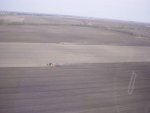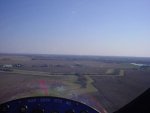But, not all blades are made carefully, especially most glass blades, and gyros are not helis. To have tracking have any effect, each blade would have to be perfectly identical to the other from root to tip in all ways and their angle would have to be perfectly identical along the whole length. That's practically impossible in a glass blade where foam is squirted into a hollow space on each blade to get them seesaw balanced. This throws off the exactness and they will not fly the same due to weight differentiations along their length. The permanent foam is oftentimes layered in haphazardly with air pockets and thick and thin spots along the way. Blades made like that will never be balanced and give a smooth ride, unless you were extremely lucky and got a set that was paid more attention to during the manufacturing process. I know...I had a set like that. Aluminum blades are much smoother overall, as there is hardly no chance of variations along their length or width. Each spar is the same and the only thing inside is air. That's pretty hard to mess up.
An engineer (and A&P, heli-pilot and Rotorway builder) who balances helis all over the world for a living and works for RADS, couldn't balance my blades over a period of months with some of the best balancing gear available. We got the blades tracking perfectly and it made no difference. As I said, some got lucky with the glass blades. Gary Brewer has glass blades and his own balancing gear. He's worked on them for years trying to get them smooth. His stick shake and "cabin-hop" are horrendous. He just can't get it out and he became a master at tracking them. He had reflectors at each tip and used a mirror in flight to shine sunlight on them and a light at dusk to where he got them perfectly tracked. Again, it didn't mean a thing as far as smoothing out the ride. My guy had a light mounted on the nose of my gyro that shone up at the bottom of the leading blade and measured the track precisely. It was a waste of time making the custom bracket for the light, because the perfect tracking did nothing as far as smoothing out the glass blades. They had too many variations along their length to be "balanceable."




